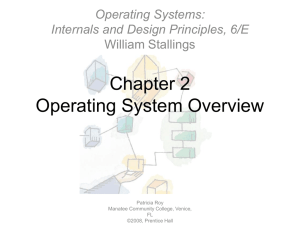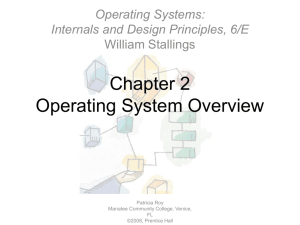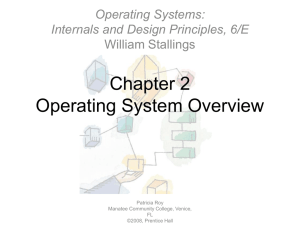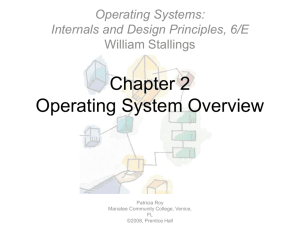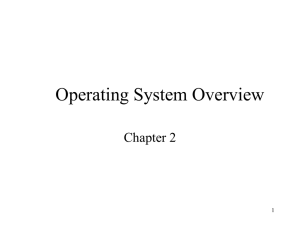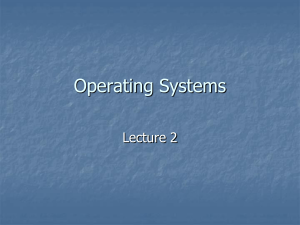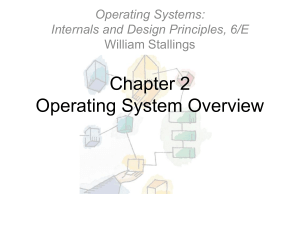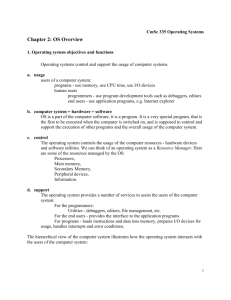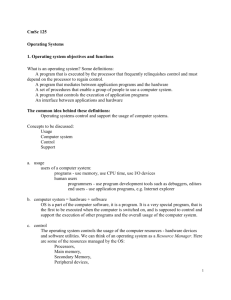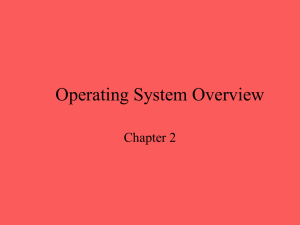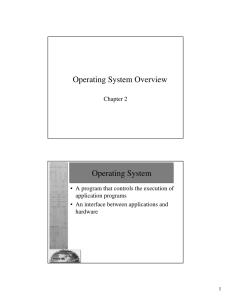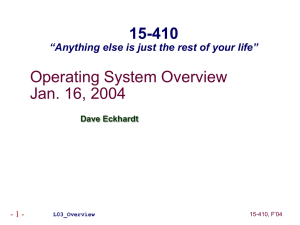powerpoint
advertisement
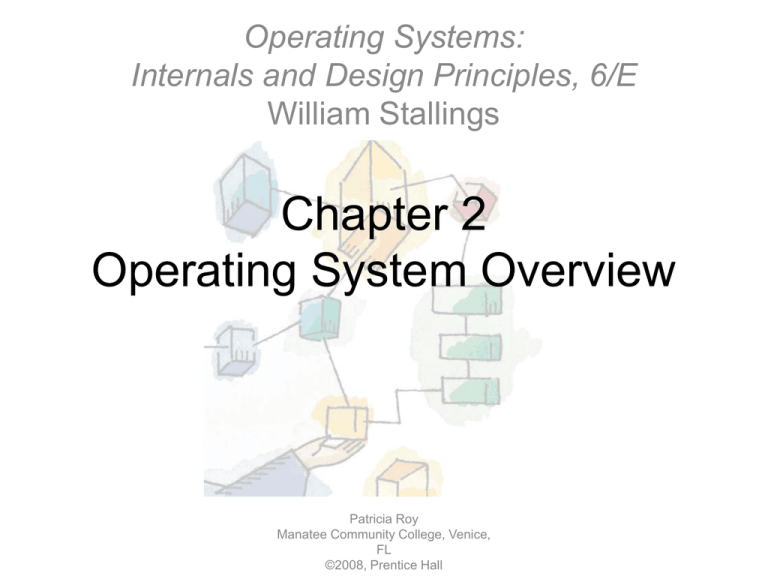
Operating Systems: Internals and Design Principles, 6/E William Stallings Chapter 2 Operating System Overview Patricia Roy Manatee Community College, Venice, FL ©2008, Prentice Hall Operating System • A program that controls the execution of application programs • An interface between applications and hardware • Resource manager Operating System Objectives • Convenience • Efficiency • Ability to evolve Layers and Views Services Provided by the OS • Program development – Editors and debuggers • Program execution • Access I/O devices Services Provided by the OS • Controlled access to files • System access Services Provided by the OS • Error detection and response – Internal and external hardware errors – Software errors – Operating system cannot grant request of application Services Provided by the OS • Accounting – Collect usage statistics – Monitor performance – Used to anticipate future enhancements – Used for billing purposes Operating System • Responsible for managing resources • Functions same way as ordinary computer software – It is a program that is executed • Operating system relinquishes control of the processor OS as Resource Manager Kernel • Portion of operating system that is permanently in main memory • Contains most frequently used functions • Also called the nucleus Evolution of Operating Systems • Hardware upgrades plus new types of hardware • New services • Fixes Evolution of Operating Systems • Serial processing – No operating system – Machines run from a console with display lights, toggle switches, input device, and printer Early “minicomputer” Evolution of Operating Systems • Serial processing – Schedule time – Setup included loading the compiler, source program, saving compiled program, and loading and linking Evolution of Operating Systems • Simple batch system – Monitor • Software that controls the sequence of events • Batch jobs together • Program returns control to monitor when finished Job Control Language • Special type of programming language • Provides instruction to the monitor – What compiler to use – What data to use IBM 360 JCL Example //IS198CPY JOB (IS198T30500),'COPY JOB',CLASS=L,MSGCLASS=X //COPY01 EXEC PGM=IEBGENER //SYSPRINT DD SYSOUT=* //SYSUT1 DD DSN=OLDFILE,DISP=SHR //SYSUT2 DD DSN=NEWFILE, // DISP=(NEW,CATLG,DELETE), // SPACE=(CYL,(40,5),RLSE), // DCB=(LRECL=115,BLKSIZE=1150) //SYSIN DD DUMMY • This copies OLDFILE to NEWFILE Hardware Features • Memory protection – Do not allow the memory area containing the monitor to be altered • Timer – Prevents a job from monopolizing the system Hardware Features • Privileged instructions – Certain machine level instructions can only be executed by the monitor • Interrupts – Early computer models did not have this capability Memory Protection • User program executes in user mode – Certain instructions may not be executed Memory Protection • Monitor executes in system mode – Kernel mode – Privileged instructions are executed – Protected areas of memory may be accessed System Utilization Example Uniprogramming • Processor must wait for I/O instruction to complete before preceding Multiprogramming • When one job needs to wait for I/O, the processor can switch to the other job Multiprogramming Utilization Histograms Example Time Sharing Systems • Using multiprogramming to handle multiple interactive jobs • Processor’s time is shared among multiple users • Multiple users simultaneously access the system through terminals Batch Multiprogramming versus Time Sharing CTSS Operation Major Achievements • • • • • Processes Memory management Information protection and security Scheduling and resource management System structure Process • A program in execution • An instance of a program running on a computer • The entity that can be assigned to and executed on a processor Process • A unit of activity characterized by – A single sequential thread of execution – A current state – An associated set of system resources Difficulties with Designing System Software • • • • Improper synchronization Failed mutual exclusion Nondeterminate program operation Deadlocks Process • Consists of three components – An executable program – Associated data needed by the program – Execution context of the program • All information the operating system needs to manage the process Process Memory Management • • • • • Process isolation Automatic allocation and management Support of modular programming Protection and access control Long-term storage Virtual Memory • Implements long-term store • Information stored in named objects called files • Allows programmers to address memory from a logical point of view Paging • Allows process to be comprised of a number of fixed-size blocks, called pages • Virtual address is a page number and an offset within the page • Each page may be located any where in main memory • Real address or physical address in main memory Virtual Memory Virtual Memory Addressing Information Protection and Security • Availability – Concerned with protecting the system against interruption • Confidentiality – Assuring that users cannot read data for which access is unauthorized Information Protection and Security • Data integrity – Protection of data from unauthorized modification • Authenticity – Concerned with the proper verification of the identity of users and the validity of messages or data Scheduling and Resource Management • Fairness – Give equal and fair access to resources • Differential responsiveness – Discriminate among different classes of jobs Scheduling and Resource Management • Efficiency – Maximize throughput, minimize response time, and accommodate as many uses as possible Key Elements of an Operating System System Structure • View the system as a series of levels • Each level performs a related subset of functions • Each level relies on the next lower level to perform more primitive functions • This decomposes a problem into a number of more manageable subproblems Levels • Level 1 – Electronic circuits – Objects are registers, memory cells, and logic gates – Operations are clearing a register or reading a memory location • Level 2 – Processor’s instruction set – Operations such as add, subtract, load, and store Levels • Level 3 – Adds the concept of a procedure or subroutine, plus call/return operations • Level 4 – Interrupts Concepts with Multiprogramming • Level 5 – Process as a program in execution – Suspend and resume processes • Level 6 – Secondary storage devices – Transfer of blocks of data Concepts with Multiprogramming • Level 7 – Creates logical address space for processes – Organizes virtual address space into blocks Deal with External Objects • Level 8 – Communication of information and messages between processes • Level 9 – Supports long-term storage of named files • Level 10 – Provides access to external devices using standardized interfaces Deal with External Objects • Level 11 – Responsible for maintaining the association between the external and internal identifiers • Level 12 – Provides full-featured facility for the support of processes • Level 13 – Provides an interface to the OS for the user Modern Operating Systems • Microkernel architecture – Assigns only a few essential functions to the kernel • Address spaces • Interprocess communication (IPC) • Basic scheduling Modern Operating Systems • Multithreading – Process is divided into threads that can run concurrently • Thread – Dispatchable unit of work – executes sequentially and is interruptable • Process is a collection of one or more threads Modern Operating Systems • Symmetric multiprocessing (SMP) – There are multiple processors – These processors share same main memory and I/O facilities – All processors can perform the same functions Multiprogramming and Multiprocessing Modern Operating Systems • Distributed operating systems – Provides the illusion of a single main memory space and single secondary memory space Modern Operating Systems • Object-oriented design – Used for adding modular extensions to a small kernel – Enables programmers to customize an operating system without disrupting system integrity
